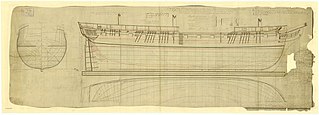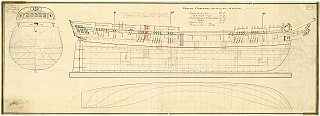
HMS Phaeton was a 38-gun, Minerva-class fifth rate of Britain's Royal Navy. This frigate was most noted for her intrusion into Nagasaki harbour in 1808. John Smallshaw built Phaeton in Liverpool between 1780 and 1782. She participated in numerous engagements during the French Revolutionary Wars and the Napoleonic Wars during which service she captured many prizes. Francis Beaufort, inventor of the Beaufort Wind-Scale, was a lieutenant on Phaeton when he distinguished himself during a successful cutting out expedition. Phaeton sailed to the Pacific in 1805, and returned in 1812. She was finally sold on 26 March 1828.

HMS Fantome was an 18-gun brig-sloop of the Royal Navy. She was originally a French privateer brig named Fantôme, which the British captured in 1810 and commissioned into British service. Fantome saw extensive action in the War of 1812 until she was lost in a shipwreck at Prospect, Nova Scotia, near Halifax in 1814.

HMS Havannah was a Royal Navy 36-gun fifth-rate frigate. She was launched in 1811 and was one of twenty-seven Apollo-class frigates. She was cut down to a 24-gun sixth rate in 1845, converted to a training ship in 1860, and sold for breaking up in 1905.

HMS Porcupine was a Royal Navy Banterer-class post ship of 24 guns, launched in 1807. She served extensively and relatively independently in the Adriatic and the Western Mediterranean during the Napoleonic Wars, with her boats performing many cutting out expeditions, one of which earned for her crew the Naval General Service Medal. She was sold for breaking up in 1816 but instead became the mercantile Windsor Castle. She was finally sold for breaking up in 1826 at Mauritius.
HMS Cydnus was one of eight Royal Navy 38-gun Cydnus-class fifth-rates. This frigate was built in 1813 at Blackwall Yard, London, and broken up in 1816.

HMS Severn was an Endymion-class frigate of the British Royal Navy, launched in 1813 as one of five heavy frigates built to match the powerful American frigates. The shortage of oak meant that she was built of "fir", which meant a considerably shortened lifespan. Nonetheless, the ship saw useful service, especially at the bombardment of Algiers in 1816, before being broken up in 1825.

Junon was a 40-gun Minerve-class frigate of the French Navy.

HMS Sealark was the American schooner Fly, launched in 1801 or 1811, that HMS Scylla captured in 1811. The Royal Navy took her into service as a 10-gun schooner. She participated in one notable single-ship action in 1812 that in 1847 the Admiralty recognized with a clasp to the Naval General Service Medal. She was sold in 1820.

HMS Rover was a Royal Navy Cruizer-class brig-sloop laid down in 1804 but not launched until 1808. She served in the North Sea, off the north coast of Spain, in the Channel, and on the North American station. She captured two letters-of-marque and numerous merchant vessels before being laid-up in 1815. She then sat unused until she was sold in 1828. She became a whaler that made four voyages to the British southern whale fishery between 1830 and 1848. She was last listed in 1848.

HMS Podargus was a Crocus-class brig-sloop of the Royal Navy. She participated in one major battle during the Gunboat War between Britain and Denmark. After the war she served at Saint Helena for five or six years. On her return to Britain in 1820 she was laid up; she was finally sold in 1833.
Brave, launched at Le Havre in 1793, was the name vessel of a two-vessel class of brig-rigged canonnières, i.e., gun-brigs. The French Navy renamed her Arrogante in May 1795. The Royal Navy captured her on 23 or 24 April 1798. The British Royal Navy took her into service as HMS Arrogante, but renamed her HMS Insolent some four months later. She was sold in June 1818.
Gleaner, later HMS Gleaner, was a ketch launched in 1802. She initially served as a light vessel and survey vessel. She served the Royal Navy as the "hired ketch Gleaner" from 12 July 1808 until the Navy purchased her in 1809. As a Royal Navy vessel, she served in the Mediterranean Sea, on the North American station, and off the north coast of Spain, participating in the capture of several vessels. She was wrecked off the north coast of Spain in 1814.
HMS Challenger was a Cruizer-class brig-sloop launched at Redbridge, Southampton, in 1813. She participated in the capture of a French privateer and then sailed to the East Indies. She was laid up in 1819 and sold in 1824.

HMS Wanderer was a Cormorant-class ship-sloop launched in 1806 for the Royal Navy. The Royal Navy sold her in 1817. She made one voyage between 1817 and 1820 as a whaler in the British southern whale fishery. She then sailed between Plymouth and North America until October 1827 when her crew had to abandon her at sea because she was waterlogged.
Little Catherine was launched in 1801 at Bermuda, probably under another name. She was condemned in prize in May 1809 at Barbados and entered British registry that year. At that time she traded between Liverpool and Africa. In 1813 she became a temporary packet sailing for the Post Office Packet Service from Falmouth, Cornwall. In 1813 the French Navy captured her and abandoned her after taking off her crew. The Royal Navy recovered her three days later. In 1814 an American privateer captured her but the Royal Navy recaptured her within two weeks. Her owner refused to pay salvage and turned her over to the Post Office which returned her to use as a Falmouth packet but renamed her Blucher, in honour of Prince Blucher who had helped defeat Napoleon at the Battle of Leipzig in 1813. The government sold Blucher in 1823. New owners returned her to the name Little Catherine and she continued to sail widely until she was last listed in 1845, having been sold to a Chinese owner. She was wrecked in October 1847.
HMS Nimble was a new cutter that the Royal Navy purchased in 1813. The Navy sold her in 1816.
HMS Woodlark was launched in 1808 and commissioned in 1809. The Royal Navy sold her in 1818. She then became a merchantman with her new owners retaining her name. From 1820/1821 she became a whaler, sailing out of Port Jackson. She was still sailing as late as the late 1850s.
HMS Dwarf was a Decoy-class cutter launched in 1810. She participated in the capture of a French privateer and in operations in the Gironde. After the end of the Napoleonic Wars she captured some smuggling vessels. She was wrecked in March 1824.
HMS Pioneer was a Pigmy–class schooner of the Royal Navy, launched in 1810 as a cutter. During her service with the Navy she captured one French privateer and assisted at the capture of another. In 1823–1824 she underwent fitting for the Coast Guard blockade. She then served with the Coast Guard to 1845. She was sold at Plymouth in 1849.
HMS Lyra was a Cherokee-class brig-sloop launched at Deptford in 1808 for the Royal Navy. In 1809 she was one of the vessels that participated in the Battle of Basque Roads. Thereafter, she captured numerous small prizes. Between 1812 and 1814 she served off the Spanish coast. In 1816 Lyra sailed to China as escort to a diplomatic mission. The Navy sold her in 1818. She then became a whaler. Between 1819 and 1833 she made five voyages in the southern whale fishery. She was last listed in 1833.









